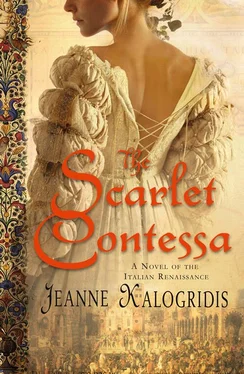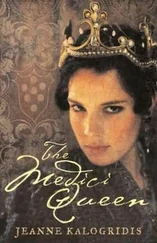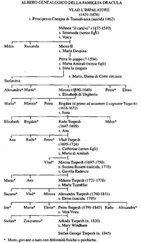At Caterina’s command, the cannon fires again, and again.
The Lady of Forlì and I have been through the experience of the Tower twice now, and survived. But this third time will surely be our last.
In the midst of the deafening song of the artillery, I see our end and our beginning. And my mind turns to the distant past. . . .
PART I
Milan
December 1476–April 1477
Chapter One
At dusk the screams came—outraged, feminine, shrill. We would never have marked them had it not been for the smoke and the singers’ sudden silence. I heard them eight days before Christmas as I stood in the loggia, gasping in stinging cold air from the open window, brusquely unshuttered by a quick-thinking servant.
A moment earlier, I had been sitting in front of the snapping hearth in the duchess’s quarters while one of her chambermaids roasted pignoli on a wood-handled iron peel—treats for the ducal heir, seven-year-old Gian Galeazzo Sforza, who stared blankly into the flames while his nurse brushed out the straw-colored curls covering his frail shoulders. Beside him sat his six-year-old brother, Ermes—thick-limbed and thick-waisted, slow to move or think—with a straight cap of dull red hair. To their left sat their mother, Duchess Bona, a sheer white veil wrapped about her coiled, muddy braids, her lips pursed as she squinted down at the needle and silk in her plump hands. She was twenty-seven and matronly; God had dealt her a stout frame, squat limbs, and a short, thick neck that dwarfed her broad face. Though her features were not unpleasant—her nose was short and round, her skin powder-soft and fine, her teeth small and fairly even—she had a low forehead with thick, overwhelming eyebrows. Her profile was flat, her eyes wide set, her small chin lost in folds of fat, most of it acquired after the birth of her first child; yet at the court of Duke Galeazzo, to my thinking, there was no lovelier soul.
To Bona’s left sat the duke’s two natural daughters, results of his dalliance with a courtier’s wife. The elder, Caterina, was, at thirteen, an example of physical perfection, with a lithe body that promised full breasts, clear skin, and a straight, well-proportioned nose, though her lips were rather thin. Two attributes propelled her past mere attractiveness into true beauty: full, loose curls of a gold so pale and bright it glittered in the sun, and eyes of a blue so intense that many who met her for the first time let go an involuntary gasp. The effect was enhanced by the natural confidence of her gaze. That afternoon, however, her gaze was sullen, for she had no patience with the needle and she hated sitting still; she paused often in her embroidery to glare at the fire and emit sighs of vexation. Had it been summer, she would have ignored the duchess’s insistence on a sewing lesson and joined her father on the hunt, or gone riding with her brothers, or chased them across the sprawling courtyard. No matter that such activities were exceedingly inappropriate for a young woman, already betrothed and certain to wed within three years. Caterina had no fear of the duchess’s wrath, not just because Bona was disinclined to anger, but also because her father the duke favored her and rarely allowed her to be punished.
The same could not be said of her nine-year-old sister, Chiara, a rail-thin, timid mouse with bulging brown eyes and a narrow, sharp-featured face. For all the attention the duke showed Caterina, Chiara—a slow-witted, obedient girl—received only his unwarranted abuse; she rarely met another’s gaze and kept close to Bona’s side. For Bona’s heart was so great that she treated all the duke’s children equally; her own son, Gian Galeazzo, who would someday rule Milan and all her territories, was shown the same tender kindness as Caterina and Chiara, both living proof of her husband’s philandering. She was also good to his two bastard sons, who were then almost men, off in Milan learning the military arts at their stepfather’s home. Although she had encouraged all of us children to address her as our mother, Chiara alone called her Mama. Caterina called her Madonna, my Lady; I called her Your Grace.
Bona was kind even to me, a foundling of murky origin. She claimed publicly that I was the natural child of one of her disgraced cousins in Savoy, and therefore related to the king of France. I had only the vaguest memory of a beautiful raven-haired woman, her features blurred by time, who murmured endearments to me in French; surely this had been my mother. I had recollections, too, of kindly nuns who cared for me after the raven-haired woman had disappeared. But when I pressed Bona privately on the subject, she refused to give any details, hinting that I was better off not knowing. She adopted me as her daughter—if a lesser one, fated to spend my days as her most coddled lady-in-waiting. I was grateful, but ashamed of my origins. And being ashamed, I imagined the worst.
Almadea, she named me: soul of God. Over the years, I came to be called simply Dea, but Bona made sure I never lost sight of my soul. She was a pious woman, given to prayer and charity, eager to raise her children to serve God. Since Caterina took no interest in the invisible world, Gian Galeazzo was destined for a secular fate, and Chiara was slow, I alone was the diligent recipient of her ardent religious instruction.
The duke, who praised Caterina to the skies and cursed poor Chiara, had little to say to or of me. I was strictly Bona’s project—although I, four years older than Caterina and often her chaperone, had many opportunities to be in the presence of His Grace, who doted on his blue-eyed, golden-haired daughter and paid her frequent visits. At those times, his eyes belonged to Caterina, and in those rare instances when his gaze strayed and caught mine, he quickly averted it.
On that eighth day before the Feast of the Nativity, the castle at Pavia—the duke’s favorite country lodgings—was bustling. Every servant’s expression was one of harried determination, every courtier’s one of eager anticipation. In two days, the entire court of several hundred would make the daylong procession to the city, Milan, and the majestic Castle of Porta Giovia. There, on the day before Christmas, the duke would address the people, issue pardons, and distribute charity; when the sun set, he would ceremonially light the ciocco, the great Yule log, for his staff and servants in the great banquet hall. The fire would be faithfully tended throughout the night. The duke had never lost his childhood love of the holiday, so he also privately celebrated the ciocco ritual with his family each Christmas Eve, followed by a lavish banquet.
On that particular afternoon, in a festive gesture anticipating the annual pilgrimage, the duke sent a quartet of carolers to his wife’s chambers. These were members of Duke Galeazzo’s choir, the most magnificent in all Europe. The duke took only a vague interest in the arts, leaving the acquisition of books and paintings to his underlings, but music was his passion, and he took great care to seek out the most talented vocalists and composers in all of Europe.
Gian Galeazzo, Ermes, Duchess Bona, Caterina, Chiara, and I sat facing west before the fire, with the open doorway to our left, while the carolers—two men and two lads, the latter chosen by the duke for their pretty bodies as much as their talent—stood just left of the hearth, lifting their amazing voices in song. Behind us, two chambermaids were busy packing Bona’s Christmas wardrobe into two large trunks. Sitting on the floor by his elder brother’s feet, Ermes dozed while little Gian Galeazzo sat dutifully enduring his nurse’s brush as he stared into the fire and listened; Duchess Bona hoped that the boys would catch their father’s passion for music. She and Chiara were distracted by their embroidery, and Caterina by a wooden ball at her foot, a toy belonging to her younger half-brothers. She slyly nudged it with her toe until it rolled a short distance and gently bumped the nose of the dozing greyhound coiled at Bona’s feet. The dog—three-legged and, like me, one of Bona’s rescues—opened one eye and promptly returned to its nap.
Читать дальше












